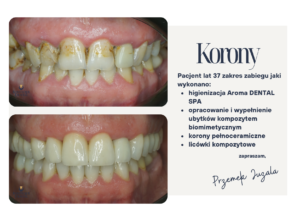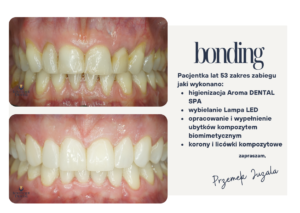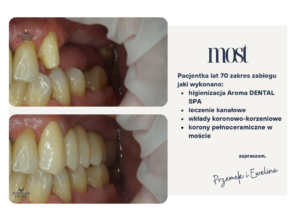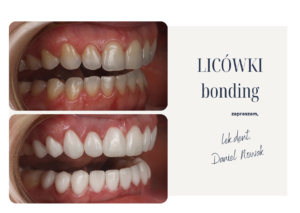THE ART OF PROSTHETICS
PROSTHODONTICS & SMILE TRANSFORMATIONS
This is a field of dentistry that has evolved into a passion lasting over 20 years. Every day, it allows us to create work that enables you to share smiles with others. Our specialists delve into the latest and most aesthetic solutions for prosthetic restorations.
We are confident that they meet the high expectations of our patients and provide a sense of comfort while eating. In response to your aesthetic demands, we have eliminated prosthetic restorations based on metal frameworks. We want you to fully enjoy aesthetics and feel at ease during gatherings with friends. The limitless imagination and creativity of the technicians we collaborate with allow us to construct porcelain restorations in the most natural and anatomical way possible.
Challenges Facing Modern Dental Prosthetics:
- Absence of a single tooth
- Missing several teeth
- Complete edentulism
- Discoloration from pharmacological treatment
- Damaged enamel due to trauma
- Poorly executed prosthetics lacking functionality and aesthetics
Our prosthetic team will quickly develop a tailored plan to address your specific needs and restore your dental integrity. This includes the creation of single crowns on post-and-core foundations, preparing patients for minimally invasive veneers, or reconstructing missing teeth with implants. Each procedure is individually customized to meet the unique requirements of our patients.


YOUR COMFORT IS IMPORTANT!
When planning prosthetic work, we prioritize your comfort with a 3-in-1 approach:
– Comprehensive digital diagnostics with low radiation exposure
– Experienced ceramists in external laboratories
– Dental scanner – eliminating unpleasant impressions
– Sensory care through relaxing music, reduced lighting intensity, and aromatherapy.
What is the ART of boutique PROSTHETICS?
What makes it superior to classical methods? What is the difference between traditional impressions and scans? What are the possibilities of modern prosthetic restorations? Digital art focuses on transferring all types of laboratory work into the virtual world, starting from smile creation, through designing restorations, to their actual fabrication.
With an intraoral scanner, we can transfer the patient’s oral situation 1:1 directly to the computer, where we can work on future prosthetic restorations using specialized prosthetic-architectural graphic software. The scanning process is relatively quick and uncomplicated, and most importantly, it is not taxing for the patient.
Designing restorations directly after the scan on the computer screen allows us to bypass stages that were traditionally prone to errors, significantly reducing the time required to complete the work. In classical prosthetics, traditional impressions necessitated the creation of plaster models before actual design work could begin. This often involved using special wax, which was later replaced with desired materials. Unfortunately, at each of these stages, inaccuracies could arise from material properties such as minor shrinkage or improper surface replication.


By taking a scan, we can monitor and compare the obtained image with the actual situation in the patient’s mouth, enabling us to easily capture all desired surfaces of the teeth and mucosa. The model is created in real-time on the monitor screen, eliminating the need for plaster pouring, which aligns with our commitment to ecology and environmental care. While there are instances where we work in an analog style, these are now rare.
Immediately after the scan, we can send the files containing the patient’s dental scan, expediting the process of starting the design of the prosthetic restoration by the external laboratory. In the digitized world of prosthetics, we seldom use trays and impression materials, thus avoiding issues related to gag reflexes or fears of choking on the material.
In boutique prosthetic art, we can utilize a variety of materials, but we most commonly use pure ceramic and zirconia. We have moved away from metal-based restorations. Our focus is on achieving maximum aesthetics, and both of these materials can provide that. Ultimately, it depends on the needs and expectations of the patient.
WE MOST COMMONLY PERFORM:
– FULL-CERAMIC VENEERS
– NON-PREP CERAMIC VENEERS – the most exclusive form of prosthetics
– FULL-CERAMIC CROWNS AND BRIDGES
– RESTORATIONS ON SINGLE TOOTH IMPLANTS
– BRIDGES AND PROSTHESES ON ALL-ON-X IMPLANTS



